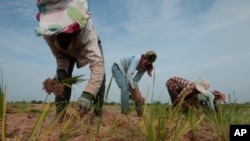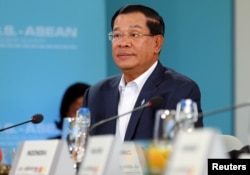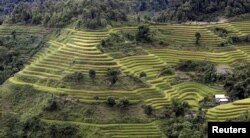Drought in Southeast Asia is raising concerns in the Cambodian and Vietnamese countryside where salinity levels are rising in the Mekong River and people are skeptical about fresh promises from Laos that it will respect the rights of downstream countries in dam construction.
The reassurances from Vientiane were delivered by Bounhang Vorachith, who was recently named secretary-general of the Laos Communist Party, sparking hopes he might show a more conciliatory approach to negotiations with countries who share use of the Mekong River.
“Laos will make an effort to ensure that there will be no impact,” Bounhang recently told the Cambodia government in regards to Vientaine’s plans to build 11 dams along the Mekong River and their impact on neighboring countries.
He also reminded Prime Minister Hun Sen that Laos had studied the potential impact of the dams and promised to limit the impact of the controversial Don Sahong hydropower dam, The Phnom Penh Post reported, to be built just north of the Cambodian border.
But his promises rang hollow among those who depend most on the Mekong River where low water levels caused by a severe drought have been blamed on climate change, clearing of rain forests for industrial use and upstream dams, mainly in China.
Up to 70 million people live a hand-to-mouth existence along the banks of the Mekong River, including indigenous tribes such as the Jarai, Kraol, Phnong, Ro Oung, Stieng, Su, Oey, Kreung and Tampuan.
Samin Ngach, a spokesman for the Cambodia Indigenous Youth Association, said food and fresh water supplies were in tight demand following weak rice harvests caused by a lack of rain during the last wet season.
“The indigenous community, they could not plant rice. Finally they have no food to eat,” Ngach said. “The forest also needs water and also the animals as well they also need the water. It's difficult for people.”
He said the ability of regional authorities to cope with the drought is also a concern. This was highlighted by a decision in Thailand last month to divert the Mekong River into drought-stricken areas, causing concern in Vietnam and Cambodia.
Hanoi pressed Bangkok to use the Mekong River Commission (MRC) for resolving such issues before they escalate in the future. The MRC, however, has suffered large funding cuts from international donors who are upset with the commission and allegations of mismanagement and corruption.
“That's the main source of fresh water fish for Cambodians, that's certainly significant. I think climate change could be felt now,” said Ou Virak, head of the local think tank Future Forum. “The heat comes very very early, there's hardly any real winter anymore there's no real cool season anymore.”
Climate change, he said, was also leaving its mark on regional diplomacy, with China commanding control of the water flowing into the Mekong River through an extensive dam network constructed over the last 20 years.
It's a huge advantage at the negotiating table with the Mekong River countries: Cambodia, Laos, Myanmar, Thailand and Vietnam.
“But also you look at the dams upstream in China. I think that will definitely have an impact not just on fisheries but also on the water supply,” Ou Virak added. “Downstream countries, including Vietnam, Cambodia, will have to find ways to negotiate with China.”
Vietnamese farmers are facing major crop losses due to severe drought and salt water contamination of agricultural land in the Mekong Delta and its 12 Vietnamese provinces. Some reports say salt water contamination has reached the Cambodian border.
Vietnam's Minister of Agriculture and Rural Development, Cao Duc Phat, is quoted in a state-run media outlet as saying 139,000 hectares of land within that country's borders have been contaminated by salt so far, and this will continue to rise at least until the start of the next rainy season, which is usually in June.
He said 575,000 Vietnamese were suffering from fresh water shortages alongside business like hospitals, schools, hotels and industry.
Tek Vannara, Executive Director of The NGO Forum, said a further 200,000 hectares of rice fields have been destroyed by the drought in Cambodia, and this was having a very bad impact on the lives of farmers, blaming most of the losses on increased salinity.
“The rice field, it is destroyed from the droughts,” he said.
“The salt, it comes from the deforestation in the whole of the Mekong region,” he said, adding the wholesale conversion of land that once sustained forests to agricultural and industrial use and made the problem much worse.
“In Cambodia, in Laos, in Vietnam or in Thailand, they already convert - to be agricultural development to be industrial. So this is another root cause,” he said.










